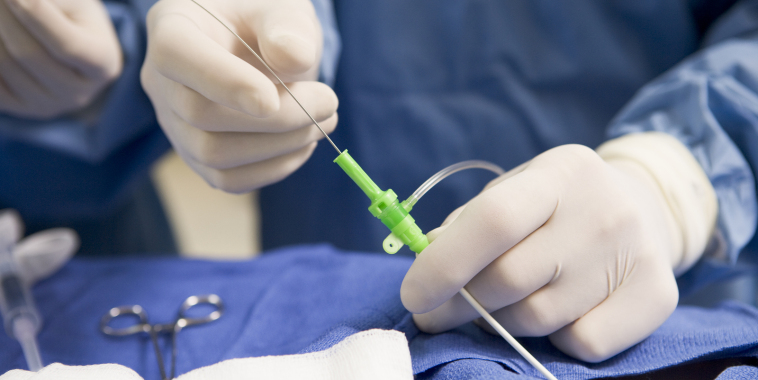
October 6, 2014
Thrombolysis for Deep Vein Thrombosis
In the absence of arterial compromise, the treatment of symptomatic deep vein thrombosis (DVT) has long plagued clinicians. The mainstay of chronic therapy— anticoagulation—prevents clot propagation and recurrent thrombosis but offers little acute relief to patients with painful DVT and has low success rates in forestalling post-phlebitic syndrome. The alternative, thrombolysis, carries its own risks, including major bleeding and increased initial costs, but may be an important option in select patients and offer downstream economic benefits.
Post-phlebitic syndrome
Post-phlebitic (post-thrombotic; PPS) syndrome affects up to 20-50% of patients within two years after a DVT, despite adequate medical therapy (1). Patients experience lifestyle-limiting pain, edema, venous ectasia, hyperpigmentation, and venous ulceration; severity is typically assessed using the Villalta score, which tallies 5 symptoms and 7 clinical signs into a cumulative point total (with >15 points being severe).
Patients at highest risk include those presenting with initial symptoms, iliofemoral DVT, female gender, advanced age, obesity, and a history of prior DVT. Importantly patients with iliofemoral DVT who are treated with anticoagulation alone have a 2.4-fold increased recurrence rate compared with femoropopliteal DVT patients. (2) Exercise training, elastic compression stockings, and intermittent pneumatic compression have a limited role in preventing and treating PPS and cannot be used in the presence of ulceration. (3)
Thrombolysis for post-phlebitic syndrome
Thrombus removal may reduce rates of PPS by eliminating residual thrombus and improving vascular function. Options include operative thrombectomy or catheter-directed thrombolysis, either of which may be coupled with treatment of associated vascular stenosis or insufficiency with stenting or bypass. Catheter directed infusion improves drug delivery directly within the thrombus, and may be done with or without mechanical thrombectomy utilizing high-powered irrigation / rheolysis (e.g., AngioJet©, MEDRAD, PA, USA), catheter osscilation / rotation (e.g., Trellis, Covidien, MA, USA), or ultrasound enhancement (e.g., EKOS, EKOS Corporation, WA, USA).
Catheter-directed thrombolysis (CDT) has been employed for over a decade but suffers from a paucity of robust, prospective data. Retrospective and small prospective studies have shown improved quality of life measures, reduction in residual thrombus, and that elimination of thrombus correlates with positive questionnaire results. (4,5,6) The addition of mechanical thrombectomy to CDT shortens hospital stays and decreases lytic doses compared to catheter-directed lysis alone. (7) A large retrospective study of the Nationwide Inpatient Sample (NIS) database reviewing over 3649 cases of CDT found no improvement in in-hospital mortality, but an increase in cost ($80,094 vs. $28, 164; p<0.001), blood transfusion (11.1% vs. 6.5%; p<0.001), and intracranial hemorrhage (0.9% vs. 0.3%; p<0.03) associated with CDT compared with propensity-matched patients with proximal DVT who were treated with anticoagulation alone. (8)
On the other hand, one of the largest prospective randomized trials, CaVenT, suggested improved clinical outcomes with CDT. The trial randomized 209 patients with iliofemoral DVT to CDT vs. anticoagulation alone and found a significant reduction in PPS at 2 years (41.1% vs. 55.6%; p=0.047) as well as increased venous patency (659% vs. 47.4%; p=0.012) with only 8 patients in the CDT arm having major bleeding events. (9)
A Cochrane meta-analysis of 17 trials (n = 1103) found similar results: a statistically significant reduction in PPS (RR 0.64; p<0.0001) at the cost of increased bleeding (RR 2.23; p=0.0006). However, the review included 15 trials using systemic thrombolysis and only two using CDT. (10)
The ATTRACT trial
Important evidence on the effectiveness of catheter-directed lysis will come from the ongoing Acute Venous Thrombosis: Thrombus Removal With Adjunctive Catheter-Directed Thrombolysis trial (ATTRACT; NCT00790335). (9) The trial plans to enroll 692 patients with symptomatic proximal DVT involving the iliac, common femoral, and/or femoral vein. Participants will be randomized to anticoagulation (control) versus anticoagulation plus intrathrombus delivery of recombinant tissue plasminogen activator (rt-PA) using one of three platforms: (a) Trellis-8 Peripheral Infusion System; (b) AngioJet Rheolytic Thrombectomy System; (c) Multisidehole infusion catheter. Anticoagulation will be initiated with heparin, enoxaparin, dalteparin, or tinzaparin followed by long-term warfarin (INR 2.0-3.0).
>span class="s2">http://clinicaltrials.gov/show....
References
1) S.R. Kahn, I. Shrier, J.A. Julian. Determinants and time course of the postthrombotic syndrome after acute deep venous thrombosis. Ann Intern Med. 2008; 149: 698–707
2) Douketis JD, Crowther MA, Foster GA, Ginsberg JS. Does the location of thrombosis determine the risk of disease recurrence in patients with proximal deep vein thrombosis?
Am J Med. 2001; 110:515-519.
3) P. Prandoni, A.W. Lensing, M.H. Prins, et al. Below-knee elastic compression stockings to prevent the post-thrombotic syndrome: a randomized, controlled trial. Ann Intern Med. 2004; 141: 249–256.
4) Comerota AJ, Throm RC, Mathias SD, Haughton S, Mewissen M. Catheter-directed thrombolysis for iliofemoral deep venous thrombosis improves health-related quality of life. J Vasc Surg. 2000 Jul;32(1):130-7.
5) Grewal NK, Martinez JT, Andrews L, Comerota AJ. Quantity of clot lysed after catheter-directed thrombolysis for iliofemoral deep venous thrombosis correlates with postthrombotic morbidity. J Vasc Surg. 2010 May;51(5):1209-14.
6) Mewissen MW, Seabrook GR, Meissner MH, Cynamon J, Labropoulos N, Haughton SH (1999) Catheter-directed thrombolysis for lower extremity deep venous thrombosis: Report of a national multicenter registry. Radiology 211:39–49
7) Kim HS, Patra A, Paxton BE, Khan J, Streiff MB. Catheter-directed thrombolysis with percutaneous rheolytic thrombectomy versus thrombolysis alone in upper and lower extremity deep vein thrombosis. Cardiovasc Intervent Radiol. 2006; 29: 1003-7.
8) Bashir R, Zack C, Zhao H, Comerota, A, Bove, A. Comparative outcomes of catheter-directed thrombolysis plus anticoagulation vs anticoagulation alone to treate lower-extremity proximal deep vein thrombosis. JAMA Intern Med. 2014; 174: 1494-1501.
9) Enden T, Haig Y, Kløw NE, Slagsvold CE, Sandvik L, Ghanima W, Hafsahl G, Holme PA, Holmen LO, Njaastad AM, Sandbæk G, Sandset PM; CaVenT Study Group. Long-term outcome after additional catheter-directed thrombolysis versus standard treatment for acute iliofemoral deep vein thrombosis (the CaVenT study): a randomised controlled trial. Lancet. 2012;379:31-8.
10) Watson L, Broderick C, Armon MP. Thrombolysis for acute deep vein thrombosis. Cochrane Database Syst Rev. 2014; 1:CD002783. doi: 10.1002/14651858.CD002783.pub3.
11) Comerota AJ. The ATTRACT trial: rationale for early intervention for iliofemoral DVT. Perspect Vasc Surg Endovasc Ther. 2009; 21: 221-4.
